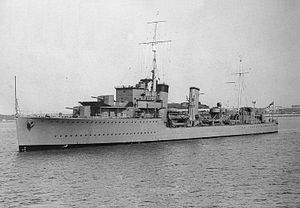HMS Kempenfelt (I18)

HMS Kempenfelt in August 1933
|
|
| History | |
|---|---|
|
|
|
| Class and type: | C-class destroyer |
| Name: | Kempenfelt |
| Namesake: | Rear Admiral Richard Kempenfelt |
| Awarded: | 15 July 1930 |
| Builder: | J. Samuel White, Cowes |
| Laid down: | 18 October 1930 |
| Launched: | 29 October 1931 |
| Completed: | 30 May 1932 |
| Fate: | Transferred to Royal Canadian Navy, 19 October 1939 |
|
|
|
| Class and type: | River-class destroyer |
| Name: | Assiniboine |
| Namesake: | Assiniboine River |
| Commissioned: | 19 October 1939 |
| Decommissioned: | 8 August 1945 |
| Motto: | Fideliter (Latin: "Faithfully") |
| Nickname(s): | "Bones" |
| Honours and awards: |
Atlantic 1939-45, Biscay 1944, English Channel 1944-45 |
| Fate: |
|
| Badge: | Badge: On a field Black a Sword proper between two wings greenover two wavelets Silver and Blue. |
| General characteristics | |
| Displacement: |
|
| Length: | 329 ft (100.3 m) o/a |
| Beam: | 33 ft (10.1 m) |
| Draught: | 12 ft 6 in (3.8 m) |
| Installed power: | 36,000 shp (27,000 kW) |
| Propulsion: |
|
| Speed: | 36 knots (67 km/h; 41 mph) |
| Range: | 5,500 nmi (10,200 km; 6,300 mi) at 15 knots (28 km/h; 17 mph) |
| Complement: | 145 |
| Armament: |
|
HMS Kempenfelt was a C-class destroyer built for the Royal Navy in the early 1930s. A flotilla leader, she saw service in the Home Fleet before World War II and the ship made several deployments to Spanish waters during the Spanish Civil War, enforcing the arms blockade imposed by Britain and France on both sides of the conflict. Kempenfelt was transferred to the Royal Canadian Navy (RCN) in 1939 and renamed HMCS Assiniboine. During World War II, she served as a convoy escort in the battle of the Atlantic, sinking one German submarine by ramming, on anti-submarine patrols during the invasion of Normandy, and was employed as a troop transport after VE Day for returning Canadian servicemen, before being decommissioned in mid-1945. Assiniboine was sold for scrap in 1945, but she ran aground while being towed to the breakers and was not broken up until 1952.
Kempenfelt displaced 1,390 long tons (1,410 t) at standard load and 1,901 long tons (1,932 t) at deep load. The ship had an overall length of 329 feet (100.3 m), a beam of 33 feet (10.1 m) and a draught of 12 feet 6 inches (3.8 m). She was powered by Parsons geared steam turbines, driving two shafts, which developed a total of 36,000 shaft horsepower (27,000 kW) and gave a maximum speed of 36 knots (67 km/h; 41 mph). Steam for the turbines was provided by three Yarrow water-tube boilers. Kempenfelt carried a maximum of 473 long tons (481 t) of fuel oil that gave her a range of 5,500 nautical miles (10,200 km; 6,300 mi) at 15 knots (28 km/h; 17 mph). The ship's complement was 175 officers and men.
...
Wikipedia
